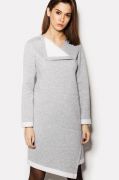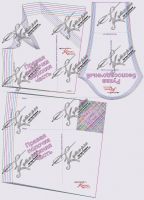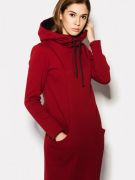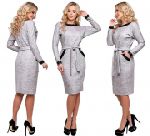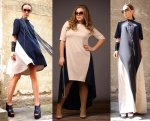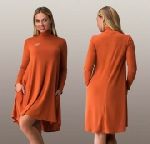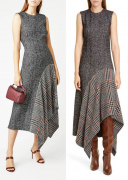Size charts What is the height of the pattern Payment methods Ask a question Reviews
An electronic pattern of a trapezoid dress for printing in full size on a home printer or plotter. Printed on standard sheets of paper from A4 to A0.
 Free download instructions on how to sew a dress for this pattern...
Free download instructions on how to sew a dress for this pattern...
How to sew an asymmetry asymmetry dress from a footer according to a finished pattern with your own hands
Read this pattern instructions:
- The style of the dress and a set of patterns for its tailoring, fabric consumption.
- How to download, print and assemble patterns with your own hands.
- Features of cutting a dress of this style with your own hands.
- How to cut and sew this dress step by step:
Download PDF pattern of this dress
Features of the style that are included in the set of patterns for sewing a dress and fabric consumption
Electronic pattern of a-line dress "asymmetry" from the footer
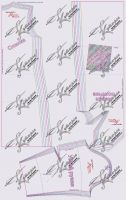 Sizes: 40-52 and 52-64 (the buyer receives all sizes of the selected gradation 40-52 or 52-64)
Sizes: 40-52 and 52-64 (the buyer receives all sizes of the selected gradation 40-52 or 52-64)
File format for download in order:
PDF in full size and without seam allowances.
After paying for the order, you will receive links to download two files patterns of a dress of the gradation of the sizes chosen by you:
- PDF file A4, adapted for printing patterns on sheets of A4 paper in any program on any device, including mobile phones.
- Multi-format PDF file for printing on sheets of any size from A0 to A4 on a printer or plotter using Adobe Reader.
Sewing difficulty level: medium.
This style a line dresses fits most figures of different fullness and different heights. This dress will please both lovers of casual style and admirers of boho styles.
For sewing, you will need a modern overlock with the ability to adjust the knitted seam (do not confuse it with an overcasting seam) and a machine with a zigzag adjustable in width.
A set of patterns for sewing a dress includes
- back pattern;
- pattern of the left shelf;
- pattern of the right shelf - upper and lower parts;
- mold narrow sleeve - for small sizes and tapered sleeves - for large sizes;
- mold non-stop sleeve, which does not need to be swept in.
The facing for the neck is cut out according to the patterns of the shelf and back (picture 2) and is therefore not included.
What fabric to sew this dress and consumption
The approximate consumption of fabric for a trapeze dress with a footer width of 180 cm, depending on the size, will be from 150 to 170 cm.
You can use a double-thread footer of different thicknesses and a footer with a "felt" fleece, as well as fleece. It will take another 10 cm of thin knitted dublerin.
Of course, this dress can also be sewn from other fabrics of the dress assortment with a width of 140 - 150 cm. The fabric must have sufficient density and strength to withstand the pocket. The consumption in this case will increase to two product lengths + 10 cm and will be 210 - 230 cm.
A particularly good substitute can be considered dense denim and linen. Sundresses (sleeveless jackets) made of jeans or suit linen will also look good. In this case, the dublerin can be ordinary or replaced with adhesive interlining.
How to download, print and assemble a do-it-yourself pattern for sewing a dress
How to buy an electronic pattern
How to choose a pattern size without taking measurements and using tables
How to print a life-size pattern at home on A4 sheets
How to assemble a pattern after printing.
Ready-made patterns of dresses in full size free download.
Download this PDF dress pattern
Features of cutting a dress of this style with your own hands
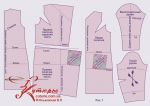 Let's start, as usual, with the questions you want to ask.
Let's start, as usual, with the questions you want to ask.
Why do you need a tuck on the shelves?
The tuck is needed for a good fit on the chest. Dart from the armhole, thanks to the "oblique" location, allows you to easily adjust yourself if necessary: shorten, lengthen, shift the top, deepen and even completely abandon the tuck.
In addition, the presence of a tuck allows you to choose a slightly smaller size than in its absence, which will help curvy girls not to increase their size.
Let's consider in more detail the possibility of refusing to tuck
(picture 2).
Refusal of the chest tuck should not be considered by happy owners of lush breasts, as well as owners of large sizes.
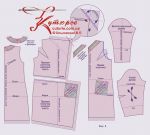 If you want to ditch the bust dart, try on a sleeveless dress with a shirred dart to determine which option will have the best fit.
If you want to ditch the bust dart, try on a sleeveless dress with a shirred dart to determine which option will have the best fit.
If you refuse a chest tuck, what to do Not recommended the vast majority of women, the armhole is easy to redo from the tuck to the side seam (see the blue dotted line on 2 drawing). But in this case, the armhole will lengthen, and the fit of the sleeve will decrease.
How to get out of this situation?
- Exit first - take a larger sleeve.
- Second exit - reduce the fit or “deepen” the lower sleeve hem when tucking in. But, if you use a non-stop sleeve, then when sewing from stretch fabrics, the amount of fit does not matter - it can be small or large, absent or negative (the latter in large volume products).
Why do you need a non-stop sleeve? And why are there no notches?
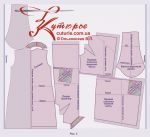 The first answer has already been given - a non-stop sleeve does not care about the difference in the length of its eyelet and armhole, so it is convenient to use it in stretch products or when changing the length of the armhole in large-volume products (Pg from 6 cm). The non-stop sleeve is sewn in without stitching and without taking into account the highest point of the eyelet, that is, the notches here can only confuse the novice couturier.
The first answer has already been given - a non-stop sleeve does not care about the difference in the length of its eyelet and armhole, so it is convenient to use it in stretch products or when changing the length of the armhole in large-volume products (Pg from 6 cm). The non-stop sleeve is sewn in without stitching and without taking into account the highest point of the eyelet, that is, the notches here can only confuse the novice couturier.
I will tell you one secret: couturiers choose sleeves of any design not according to the length of the armhole, but according to their width, not paying attention to the difference in the length of the armhole and the armhole. And the so-called "control points", if they are applied, then on the fitting after the base of the armhole. Only this method ensures a perfect fit.
Help for beginners video how to sew a sleeve without stitching
Where is the pocket burlap?
The "location of the pocket" is, in fact, its burlap.
Now consider the seam allowances.
Usually, when sewing a stretch with a knitted seam on an overlock, seam allowances are not added, since the seam width is 0,5 cm. The decrease in seam width is compensated by the extensibility of the fabric, and we will also cut if the parts are cut out beyond the stroke line of the part.
But when sewing this model, allowances will still be needed along the bottom of 2,5 - 3 cm and along the side of the right shelf 2,5 - 3 cm, as well as along the cut line of the right shelf 1 - 1,5 cm. Above the tucks are "houses".
If you are going to sew this dress in a stable fabric like linen or denim, you will need to add the same seam allowances as you would for a regular A-line.
How to cut and sew an asymmetry dress from a footer according to a finished pattern step by step
Cutting trapezoid dresses "asymmetry" is not difficult
- We cut the spreading fabric in one layer - in a turn. We lay out the details in the most economical way, taking into account the shared direction and with allowances on the front side of the footer. All labels up. For cutting dress back you can fold the fabric in half and, cutting it out, cut the rest of the details.
- How to cut out facings? We cut out the facings for the sprout (neck of the back) and for the neck of the left shelf, as usual, from dublerin without seam allowances, using the patterns of the back and left shelf. For the right front, facing is not needed - there we have a side, which we process into an open cut hem (for footer) or a closed cut (double hem for linen and jeans).
- It is more convenient to cut the facing of the sprout in a turn. The facing of the neck of the right shelf is cut out in a single copy. Dubbing - we put the shelf pattern on the glueless layer with the inscriptions up, in the same way, the facing will be mirrored to the left shelf.
- Please note that for the left shelf it is desirable to make a one-piece facing by attaching a dubbing blank to the neck of the shelf when cutting (picture 3). One-piece facing will significantly speed up and simplify the processing process, and besides, it will make the edge of the neckline thinner. Remember that the footer, especially with a “felt” fleece, is a very thick fabric and therefore, where possible, we do without it.
- Do not forget the allowances for turning in places where they will be connected to each other. If you sew with a knitted seam, then 0,5 cm will be enough.
How to assemble a shelf?
- It is very important that the lines of half-slips on the right front, the location of the pocket (on both fronts), as well as the waist and hip lines (on the back and both fronts) are outlined with a lining stitch with contrasting threads and preserved until the product is ready.
- We start with the processing of breast darts - we grind with a narrow zigzag and carefully iron. We process the corner of the lapel (see below for the description) and stitch the free cut of the hem of the bead with a stitching or any decorative seam that your household sewing machine makes. Then, iron carefully.
- Watch the video to help you set up the stitcher
- Watch the video master class about the seams that replace the stitching
- Lower part of the right shelf. We start processing with a notch that will limit the pocket. The length of the notch is 1 cm. We process the corner of the edge of the pocket and the side in the same way as the lapel.
- Then we grind the lower and upper parts of the right shelf.
- In the left shelf we overcast and iron the facing and overcast the shelf along the cut of the half-skid.
- We impose the right shelf on the left, combining the semi-skids and the location of the pocket. We check whether the horizontal lines of the waist and hips coincide. We build the right shelf not to the end. Remember that we will need to process the bottom of the product after sewing the side seams.
How to process lapel corner?
- Just like the corner vents in a straight skirt (picture 2).
- Extend the sides of the lapel and draw an additional line - a bisector through the top of the corner.
- Be sure to check the length of the markup accuracy - the segments marked with blue brackets must be the same.
- Stitch, connecting the bisectors, check the correct stitching and cut off the excess fabric.
- Straighten and sweep the seam, iron.
- Further sewing of the dress does not differ from the sewing of a sweatshirt and it is performed on an overlock with a knitted seam: we sew and iron the shoulder, we sew and iron the sleeves, we sew and iron the side ones, we fold and sew the bottom.
Download this pattern pdf:
A-line dress pattern "asymmetry" from the footer
$2.00 (80 hryvnia)
Bank cards of the Russian Federation are not accepted for payment!
Size charts What is the height of the pattern Payment methods Ask a question Reviews
Vera Olkhovskaya in social networks:

See similar clothing patterns and how to sew on them
-
Any pattern for free for a review of a previously made order
More...
Lifetime promotion for buyers of patterns!

Leave a review about my store of patterns for an order that you made before, and you will receive any paid pattern of your choice Free!
